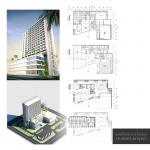A hotel consists of two major components, the business operations and the physical property. These two components
although distinctively different, are very much interdependent and affect the hotel’s ability to succeed.
An understanding of this important duality is evident in the increasingly market driven nature of hotel design. More
diverse and innovative new hotel concepts are constantly being developed based on the identification of gaps in hotel
markets, or the creation of new market segments. However, the common perception of the hotel property as being a
static and permanent entity remains the same. Despite the volatile and ever‐changing nature of hotel markets, short‐
term demand fluctuations have always been one of the biggest concerns and topics of discussion for hotel management
and marketing.
While there has been plenty of research into the problems and implicationsthatshort‐term demand fluctuations have on
hotel performance and profitability, common approaches to dealing with demand changes are very much restricted by
the physical hotel design, and limited to strategic management and marketing tactics that are often inadequate to deal
with the problem.
This thesis identifies a gap in the knowledge between hotel design and short‐term demand fluctuations. Through
research and design, it aims to bridge the gap by directing a design response targeted specifically at the nature of short‐
term demand fluctuations. The outcome of thisthesisisthe design of a new hotel proposed for Wellington, New Zealand.
The design demonstrates how particular flexible design interventions can allow the hotel property to be more responsive
to short‐term demand fluctuations, and its potential to improve business performance and operating efficiency.
Hotel projects follow the same general sequence as other development projects, but with some
important nuances. For instance, The future operator, is usually involved from nearly the first step,
influencing the site selection, programme, choice of consultants, and so forth. It is important to
consider how the principal management companies, the organisations with the development and
operating experience, think about a new project, and incorporate their methods and needs.
Ransley and Ingram (2004) explainsthat there are six main stagesin design and development of a hotel
property (Figure. 2).
One of the first steps is to confirm the location and particular site, and assess its suitability for a hotel.
This is partly carried out in the feasibility study from a market standpoint but, equally important, the
site needsto be evaluated from a design and construction perspective.
This is followed by feasibility studies, which assess present and future demand for lodging and such
other hotel services as meeting areas, restaurants and bars, and recreation facilities. Feasibility studies
also estimate operating income and expensesforthe 10 years afterthe hotel opens.
From this initial research, a suitable building scope and programme can be produced. The findings of
the prior research help to determine the best balance of guestroom and public facilities including
restaurants and bars, meeting and banquet rooms,retailshops,recreation facilities, and parking.
2020
2020
This indicates how full the hotel is. To calculate this, divide the total number of
room nights sold by the total number of room nights available. For example if a
hotel sells 2000 rooms in a month with 3000 room nights, the occupancy rate is
67%.
lam nguyen


